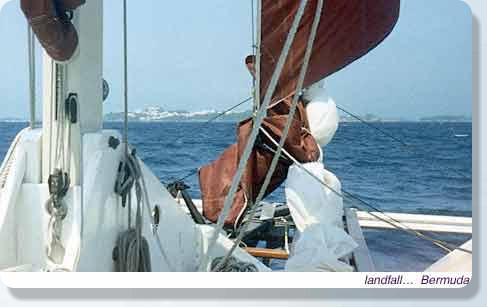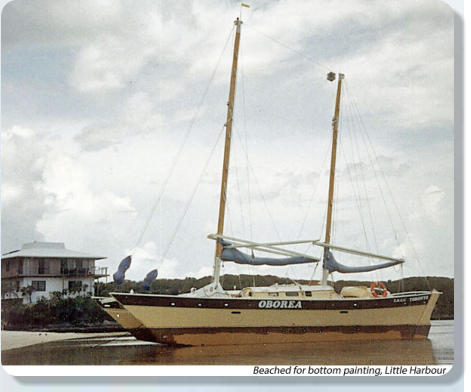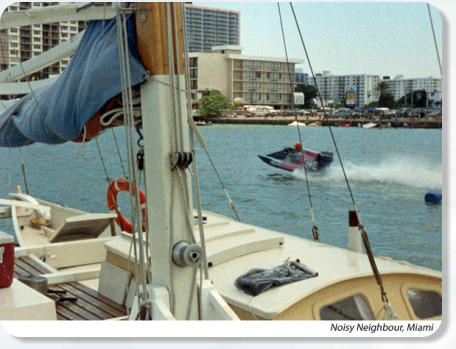Chapter 4 — Off Onto the Big Ocean
I spent almost two and a half weeks in Miami anchored off my friends at Treasure Island doing some needed work on Oborea. I spliced new stainless steel forestays to replace the old galvanized ones as the jib hanks had worn off the galvanizing and they were starting to rust. I put new anti-skid on the decks and installed a "Y" and a small holding tank in my head discharge so that Oborea is now legal. The Coast Guard have been doing a lot of spot checks recently. There was a long list of smaller jobs that also got done, getting Oborea in all respects ready for sea. The anchorage was peaceful, away from the power boat wakes that plague much of south Florida and work proceeded fairly quickly. Peaceful except for one Sunday when I was awakened by what sounded like a swarm of angry hornets. It was a hydroplane race and one of the course markers was less than twenty feet from my stern! Had an excellent view of the days events, but going ashore in the dinghy for bread and milk was pretty hazardous! I was ready to leave by May sixteenth, but the weather did not co-operate; hot, humid, thundery and windless. It was not until the eighteenth that we got a breeze, a headwind for crossing to Grand Bahama but at least I would be moving so I got going. During the ten mile run from Treasure Island to the harbour mouth I noticed that the speedometer was reading about fifty percent low, so as soon as I cleared the harbour I went over the side with mask and flippers and found out why they call Miami the barnacle capital of America. Anywhere on the hull where the antifouling had worn off as well as the log transducer had a thick layer of barnacles. I scraped them off the transducer, the rest would have to wait. Fortunately I had a gallon of antifouling on board that I planned to put on in the Bahamas. I set off with the wind vane of the Autohelm keeping me close hauled on the starboard tack heading north-northeast and diverging gradually from the land. By the time I was abeam Fort Lauderdale I was five miles off and after sunset the wind started to veer gradually taking me round in a long curve to starboard. At first sight of dawn, without touching a setting since leaving Miami, the Autohelm had brought me within sight of Settlement Point, my target, on an east-southeast course. I crossed onto the Little Bahama Bank at six fifteen and kept going. The winds were light and there were thunderstorms all around the horizon. In mid afternoon I was hit by one of the squalls and had to heave to. It was short and sharp, but afterwards I was left rolling around with no wind at all. I started the motor as I wanted to make as much progress toward Green Turtle Cay as possible in order to check in with customs before the long holiday weekend (Bahamians celebrate May twenty fourth too). At dusk I was hit by another squall, but after it passed I pulled off onto the shoulder as it were, and anchored near the shore of Abaco. Friday was warm and sunny but without wind so I motored the thirty miles to Green Turtle and anchored Oborea in her old spot in Settlement Creek, just feet from the town dock and convenient to the customs and Miss Emily’s Blue Bee Bar. Entry here was the easiest I have experienced in the Bahamas. One officer handles both customs and immigration and the only charge was ten dollars for the fishing licence. I stayed Saturday at Green Turtle Cay and on Sunday tacked ten miles to Bakers Bay on Great Guana Cay where I went over the side and tackled the barnacles. It took me two hours plus a half hour break between hulls to get them off. Next day I tacked another ten miles to Marsh Harbour to pick up the few supplies I needed. On Tuesday I sailed Oborea twenty miles to Little Harbour and put her up on the beach to paint the bottom. Unfortunately it was the time of neap tides and I would not be able to do the whole bottom, but I could not afford to wait a week for the full moon. The first day I scrubbed and put on one coat of antifouling down about eighteen inches from the waterline and on the next day I got on a second coat down about two feet so I did not do too badly. For you Little Harbour fans, Pete's Pub has reopened in its new building after the old one burned down a year ago. Back in Marsh Harbour I spent a day rushing around in the rain doing last minute chores, including a trip to customs to get clearance papers. One of the forms I received had the contradictory title ‘Entry Outwards of Vessel’! By Saturday Oborea was ready for sea and I was ready to head for Bermuda. I left Marsh Harbour with a favourable south west wind, but five miles out it changed to the north east; right on the nose. I took the starboard tack heading north looking for westerlies. That first day three whales cruising on the surface passed close to Oborea heading south east, the first I had ever seen. Calms and headwinds continued for the next four days and the best I could do was continue north without getting much closer to my target. Finally on day five the wind switched to the west, and although still light it permitted me to point right at Bermuda. Days six, seven and eight had perfect west winds and I clocked off about one hundred and forty miles a day. On one day I spoke to a Spanish freighter heading from New Orleans to the Strait of Gibraltar, he kindly read me the latest weather forecast over the VHF and then came out on the bridge wing to wave to me. He said goodbye with a blast on his hooter that nearly made me jump out of my skin and steamed away. On day nine the winds, still westerly, picked up in strength and I continued under double reefed mainsail and small jib. Just before noon I made my landfall on Gibbs Hill, the south point of Bermuda, and turned to run up the south coast of the island at twelve knots, passing two monohulls on the way. The strong winds though were my undoing. They were blowing straight out of Town Cut, the entrance to St George harbour, which is very narrow between rocky cliffs, at thirty knots with very steep little four foot seas. It was too narrow to tack and I could make no progress against the wind and waves under power so I just had to heave to and wait for it to calm down a bit. This took a frustrating thirty hours during which time I completely read two paperback novels. It was particularly frustrating because this was not a gale or anything—if I had been heading east for the Azores I would have welcomed this wind. Anyway I finally made it through the cut on day eleven and anchored in Convicts Bay, St George. An hour later the wind was back up to thirty knots. Once finally ashore the paperwork was easy, the officials friendly and I was made to feel welcome. There were yachts in the anchorage from all over the world; I could see the flags of Norway, Germany, France, England, Spain, New Zealand and BVI as well as those of the USA and Canada, but I was the only multihull. Bermuda is a complete contrast to the Bahamas. It is only twenty miles long and at the most a mile wide and all densely populated. Houses, gardens and parks are neat, clean and prosperous looking with flowers everywhere. A network of very narrow paved roads, much like English country lanes, crisscross the island and cars are strictly limited in size and only one to a family. Schoolboys in uniform play cricket and the policeman wear Bobbie helmets and (what else) Bermuda shorts. The island's prosperity comes as much from the offshore banking industry as from tourism and the place is booming. St George is the historic capital, very quaint and old, while the modern capital, Hamilton, is the financial centre with banks on every corner. They are a fifty minute bus ride apart.

